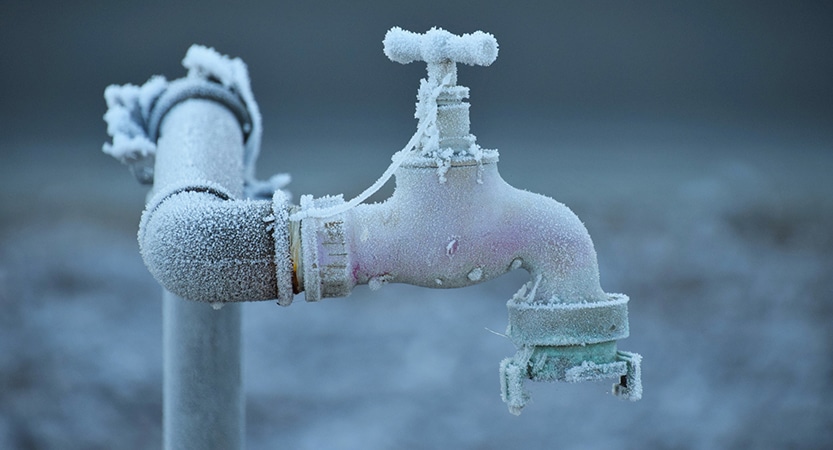Preventing Pipes from Cold Weather: Top Strategies
Preventing Pipes from Cold Weather: Top Strategies
Blog Article
We've noticed this post about Helpful Tips to Prevent Frozen Pipes this Winter directly below on the internet and think it made perfect sense to share it with you on my blog.
:strip_icc()/snow-outdoor-faucet-pipes-4af65d1e5e904fb1aa7bf74071fe5d89.jpg)
Winter can wreak havoc on your plumbing, specifically by freezing pipelines. Below's exactly how to avoid it from taking place and what to do if it does.
Intro
As temperature levels decline, the risk of icy pipes increases, possibly causing expensive repairs and water damages. Recognizing just how to prevent frozen pipes is crucial for house owners in cool environments.
Comprehending Icy Pipelines
What triggers pipelines to freeze?
Pipes freeze when subjected to temperatures below 32 ° F (0 ° C) for extended durations. As water inside the pipelines freezes, it expands, putting pressure on the pipe walls and possibly creating them to break.
Threats and problems
Icy pipes can lead to water supply disturbances, residential or commercial property damage, and pricey repair services. Burst pipes can flooding homes and cause substantial architectural damage.
Indications of Frozen Piping
Identifying frozen pipelines early can stop them from bursting.
How to recognize icy pipes
Try to find decreased water flow from faucets, uncommon smells or sounds from pipelines, and visible frost on revealed pipes.
Prevention Tips
Protecting vulnerable pipelines
Wrap pipelines in insulation sleeves or use warm tape to shield them from freezing temperature levels. Focus on pipelines in unheated or exterior locations of the home.
Home heating strategies
Keep interior areas appropriately heated up, specifically locations with plumbing. Open up cupboard doors to enable cozy air to flow around pipes under sinks.
Shielding Exterior Pipes
Garden hose pipes and exterior taps
Detach and drain pipes garden hoses prior to wintertime. Install frost-proof spigots or cover outdoor faucets with shielded caps.
What to Do If Your Pipelines Freeze
Immediate activities to take
If you think icy pipes, keep taps available to eliminate pressure as the ice thaws. Make use of a hairdryer or towels soaked in hot water to thaw pipelines gradually.
Long-Term Solutions
Architectural modifications
Think about rerouting pipelines away from exterior wall surfaces or unheated areas. Include additional insulation to attics, cellars, and crawl spaces.
Upgrading insulation
Purchase high-grade insulation for pipelines, attic rooms, and walls. Proper insulation helps keep constant temperature levels and minimizes the threat of frozen pipes.
Verdict
Avoiding icy pipes requires aggressive steps and fast reactions. By understanding the reasons, signs, and preventive measures, homeowners can secure their pipes during cold weather.
6 Proven Ways to Prevent Frozen Pipes and Protect Your Home
Disconnect and Drain Garden Hoses
Before winter arrives, start by disconnecting your garden hoses and draining any remaining water. Close the shut-off valves that supply outdoor hose bibs and leave the outdoor faucet open to allow any residual water to drain. For extra protection, consider using faucet covers throughout the colder months. It’s also important to drain water from any sprinkler supply lines following the manufacturer’s directions.
Insulate Exposed Pipes
Insulating your pipes is an effective way to prevent freezing. Pipe insulation is readily available at home improvement stores and is relatively inexpensive. Pay close attention to pipes in unheated areas such as the attic, basement, crawl spaces, or garage. Apply foam insulation generously to create a buffer against the cold. You can also wrap your pipes in heat tape or thermostat-controlled heat cables for added warmth.
Seal Air Leaks
Inspect your home for any cracks or openings that could let in cold air. Seal any holes around the piping in interior or exterior walls, as well as the sill plates where your home rests on its foundation. Additionally, make sure to keep your garage door closed unless you’re entering or exiting. Leaving it open creates a significant air leak that can lead to frozen pipes.
Allow Warm Air Circulation
During cold snaps, it’s essential to allow warm air to circulate evenly throughout your home. Leave interior doors ajar to promote better airflow. Open kitchen and bathroom cabinets to help distribute heat consistently around the rooms. If you have small children or pets, be sure to remove any household chemicals or potentially harmful cleaners from open cabinets for safety.
Let Faucets Drip
A small trickle of water can make a big difference in preventing ice formation inside your pipes. When temperatures drop significantly, start a drip of water from all faucets served by exposed pipes. This continuous flow helps prevent the water from freezing. Additionally, running a few faucets slightly can relieve pressure inside the pipes, reducing the chances of a rupture if the water inside does freeze.
https://choateshvac.com/6-proven-ways-to-prevent-frozen-pipes-and-protect-your-home/

Do you appreciate reading up on How To Avoid Freezing Pipes? Make feedback down below. We would be delighted to hear your ideas about this write-up. In hopes that you visit us again before long. Are you aware of another person who is occupied with the niche? Please feel free to promote it. Thank you so much for going through it.
Contact Us Today Report this page